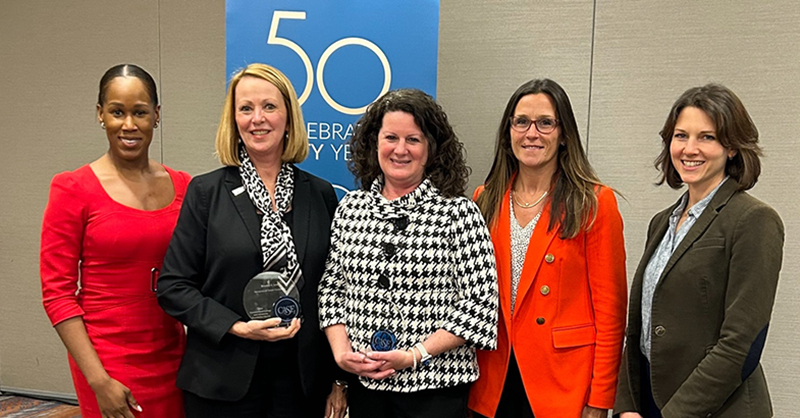Commonfund Institute provides analysis and thought leadership across the non-profit institutional investing space. But investments don’t happen in a vacuum – they are part of the institutional ecosystem with the shared responsibility of ushering in intergenerational equity and supporting organizational missions now and into the future. To promulgate best practices and advance investment knowledge in this segment we partner with and support organizations like the Council for Advancement and Support of Education (CASE).
For more than 20 years the CASE Commonfund Award has been recognizing individuals who have contributed to the advancement of the college and university foundation field. The 2024 award was presented to Brenda Lee, University of Toledo Foundation and Christy Devocelle, University of Illinois Foundation, on site at the 2024 Conference held in Denver, CO earlier this month.
 |
| From right to left: Nicole Melwood, Brenda S. Lee, Christy Devocelle, Allison Kaspriske, and Amanda Novello. |
Here are a few key takeaways from the recent event
Challenges Facing College and University Foundations Today
Internal turnover: Many sessions cited turnover as a foundational challenge facing college and university foundations today. Institutions expressed dealing with the ongoing impacts of the Covid-19 pandemic on staffing, and many advancement offices have a high rate of unfilled positions that limits the extent to which they can meet fundraising goals and address other challenges. Turnover is high at the senior leadership level too, which at the presidential level can impact donor confidence, and at the board level, can impact continuity in progress toward strategic goals. Each institution should develop a retention strategy that addresses the source of turnover unique to their institution. Succession planning was also mentioned as a key strategy to maintaining operational flow – each person in a leadership role should have clearly articulated roles and responsibilities that can be passed on to a potential successor.
Shifting donor demographics and intent: An ongoing intergenerational transfer of wealth is happening, from older donors to their children and grandchildren, including an estimated $90 trillion of assets in the next 20 years. This poses opportunities and challenges for college and university foundations. Younger donors have the benefit of seeing their donations at work, unlike those who give via a bequest. It is attractive for younger donors to realize the impact of their gift, i.e. their name on a building/room, or a scholarship given that they have funded. However, overall, college and university advancement offices are seeing a change in this newer generations’ priorities and values, which include a shift toward issue-based giving rather than institutional giving. Younger donors may be geographically dispersed, leading to less in-person engagement or affinity with an institution and they may prefer more hands-off tools like giving to DAFs (donor advised funds), which many colleges and universities do not currently self-administer due to the high costs associated. Institutions should think strategically about how their mission and goals align with that of the newer generation. Working to understand these shifts on both an individual and demographic-wide scope can help build new and maintain existing relationships and fundraising over time.
Policy changes: 1) SCOTUS striking down affirmative action in higher education admissions has left offices across institutions scrambling to figure out how to maintain programs within the bounds of the law. While the clearest application of the law is on admissions, most mentions of this issue were regarding scholarships targeted toward marginalized students. Many institutions are seeking to maintain their DEI programs, but may need to address legal hurdles, and be more intentional about how they reach their goals. 2) The 2017 Tax Cuts and Jobs Act (TCJA) nearly doubled the standard deduction level, which reduced the number of people who itemize their taxes, alongside the incentive to make tax-deductible charitable contributions. CASE and others suggest their members help advance the Charitable Act (H.R. 3435/S.566), which would restore and expand deductions for non-itemizers who make charitable donations. Many provisions in the TCJA will expire at the end of 2025 – making it something to pay attention to in the coming years.
Keys to Success: Collaboration Across Advancement, Finance, Boards, and Beyond
Many sessions emphasized the importance of collaboration between offices and teams as the key to college and university foundation success.
One case that highlights the critical importance of collaboration across investments, advancement, and staff is related to operating budgets and cash management. Sessions focused on the importance of assessing current assets and operating budget needs to optimize short-term cash. Advancement comes into play for projecting near-future fundraising. Then investment staff and committees can work to implement cash market strategies based on their respective risk and return profiles and time horizons (which may shift as the potential for interest rate reductions come into play). Governance, as always, is key: who oversees these and other strategies, who approves them, how often are they reviewed?
One session emphasized that the board’s role is not only to review strategic policies, but to be impactful for the greater good of the institution. How can a board be impactful for the greater good of the institution? One session focused on how it is more than just abiding by the duty of care, loyalty and obedience (fiduciary duty). Boards need to be strategic partners to the institutions they serve, supporting institutional missions, fundraising campaigns, long-term goals, giving to the institution and the philanthropic landscape at large, etc. They should be willing to collaborate across all levels with university and foundation leadership, alumni, staff, and students. Working together will lead to better engagement and understanding.
Across institutions, there has been a shift toward fundraising and advancement as a whole-institution effort, from events teams to advancement offices tracking donor and potential donor interests and engagement, to senior leadership and the president – a position which is increasingly taking on fundraising responsibilities. Data in the Commonfund Benchmarks Studies show there has been an upward trend in gifts to endowments in recent years. With that insight, we know that sharing the story of how endowments are used to meet mission can be a fruitful strategy and an important avenue for collaboration and engagement.
Gatherings like the CASE College and University Foundations Conference provide an important platform for institutions to discuss critical issues they face. Commonfund Institute plans to continue to explore some of those and more in the 2024 NACUBO-Commonfund Study of Endowments (NCSE), this fall. Participating in and contributing to these field building efforts, including the NCSE, helps to improve the validity and usefulness of these tools for institutions as they grapple with challenges that arise.
If you are interested in participating in the next Study or speaking with us about any of the issues covered in this post, please fill in the form below.




